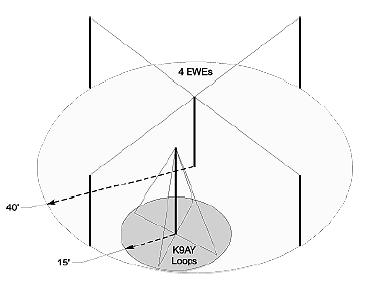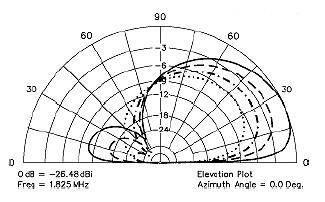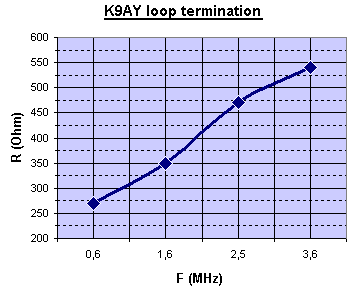

The K9AY only needs about 10m of space... compare vs. 4 EWE antennae!
The V-radiation pattern. More gain over good ground (solid graph), but F/B ratio is best over lossy ground
You don't have the space to put up a 4 beverage antenna's, an EWE or a 4-square and want 'good ears' on 160 and 80m? No problems ... try a K9AY loop antenna !
|
|
|
|
The K9AY only needs about 10m of space... compare vs. 4 EWE antennae! |
The V-radiation pattern. More gain over good ground (solid graph), but F/B ratio is best over lossy ground |
This is a very performing receiving antenna for frequencies up to 4 Mhz, which exhibits an impressive F/B ratio, especially on MF. While using the antenna, you will note that the 3 positions do not provide much signal difference (very broad receiving range) but the 4th position will always reveal it's excellent F/B characteristic claimed up to 30 dB. As with all small loop antenna's, it is recommended to boost the signal by inserting a preamplifier with a gain of at least 15 dB. I found a good schematic of preamplifier, offering up to 20 dB gain, a high 3rd order intercept point, and a bandpass filter at the input rejecting signals from the AM broadcast band and above 4MHz. See details here.
It is a as well an excellent antenna (some OM's say 'miraculous') for MW broadcast DX'ing. Listen to the following examples (mp3 files) where you will clearly hear 2 different stations, on the same frequency, while I am playing with the receiving direction example 1 example 2
As there is much literature on the net about this antenna, I will not publish it here, but just provide some pictures on my construction. Download the original paper (pdf document) from K9AY here.
The antenna is designed as a portable antenna, for setup during winter months.
 |
As the first results with my K9AY showed an
excellent F/B on MW and 160m, but much less pronounced on 80m, I
suspected that my termination resistor (the recommended 'average 470
Ohm') was not optimal. I therefore made a VACTROL and spent a couple of hours trying to measure the optimal value in function of frequency.... These measurements are indeed not easy !
Anyhow, I have managed to measure the optimal R at four frequencies, see the graph, which is consistent and confirms the values recommended (160m=390 Ohm, 80m=560 Ohm). |
|
Now, is it really worth working with a VACTROL or remote switchable resistor bank ? In my opinion, no ...it seems a little overkill:
As the remote switching solution adds complexity / fragility and requires additional cables I would rather work with a miniature switch on the control box, by which the choice 160 / 80m is made. I think that - for my activities - 90% of the time it would be in the '80m' position, even for 160m, unless working in conditions where the optimum F/B would be really required (contest ?) Off course, this can be different for you .... I imagine that if you are interested in MW, this termination resistor fine-tuning could make the difference between reception of 2 stations on same QRG! But then you should as well consider installing 2 systems to cover all directions with the best possible F/B.... Overall impression : When switching over from the K9AY to my vertical HF6V with 100 radials on 80m, the reception is certainly quiter (improved S/N), but I cannot say that I could copy every day sigs on the K9AY which were impossible to decode on the vertical. The K9AY's main advantage is more it's ability to reject signals from unwanted directions. All by all, it is a performing antenna because of low-cost, portable, and very compact. |
|